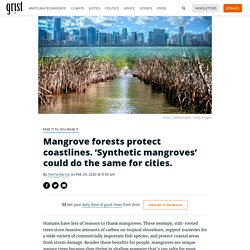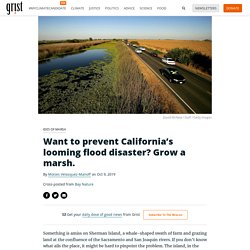

18 jlt 2021 Inondations : une menace planétaire. 11-12 juin 2021 Face à la montée des eaux, s’adapter plutôt que bétonner. [3/4 Une montée des eaux critique] Déjà affectés par l’élévation du niveau de la mer, les littoraux français doivent s’attendre à pire.

Quelles sont les zones les plus à risque ? Que projettent les scientifiques ? Comment la France s’y prépare-t-elle ? 16 mars 2021 'There’s no alternative': Louisiana's ambitious plan to stay above water. Louisiana has never been hard to pinpoint on a map — it’s the only state in the U.S. that looks like a giant boot.

At least it did, before the ocean swallowed the carbon emissions belched out by industrializing nations and began to swell. Now, the boot is losing a football field of land every hour to the rising tide. In order to save the state from sea-level rise, the Louisiana state government is embarking on a series of years-long, multi-billion dollar projects to slow the rate of land loss. This month, the U.S. Army Corps of Engineers, the federal civil works and military engineering agency, greenlighted the first of those large projects.
Mangrove forests protect coastlines. ‘Synthetic mangroves’ could do the same for cities. Humans have lots of reasons to thank mangroves.

These swampy, stilt-rooted trees store massive amounts of carbon on tropical shorelines, support nurseries for a wide variety of commercially important fish species, and protect coastal areas from storm damage. Storing carbon and saving the economy? Mangroves can do both. From Typhoon Hagibis in Japan to Cyclone Idai in Mozambique to Hurricane Dorian in the Bahamas, climate change–fueled tropical storms have been increasingly wreaking havoc on coastal regions across the globe.

Want to prevent California’s looming flood disaster? Grow a marsh. Something is amiss on Sherman Island, a whale-shaped swath of farm and grazing land at the confluence of the Sacramento and San Joaquin rivers.

If you don’t know what ails the place, it might be hard to pinpoint the problem. Scientists Put A Price Tag On Saving Coral Reefs, And They're Worth A Lot. Coral reefs might have an inherent beauty and value to wildlife and marine ecosystems that’s priceless, but if we did have to put a dollar amount on their value, it turns out they’re worth quite a bit of money.

That money isn’t coming from tourism either, it’s coming from the ecosystem services coral reefs provide protecting us from floods by acting as buffers that reduce the power of waves, which significantly reduce flooding and erosion. According to a study conducted by researchers from the U.S. Aux Maldives, on transforme la montée des eaux en solution contre les inondations. Même si l’on parvient à maintenir la hausse des températures à + 1,5°C (l’objectif de l’accord de Paris), le niveau des océans aura gagné entre 26 cm et 77 cm d'ici 2100, selon le dernier rapport du GIEC.

En première ligne, les îles et les zones côtières, où se concentre près de 40 % de la population mondiale. Coral-reefs-protect-us-from-floods-for-now. Living shorelines: How nature can help us beat back rising seas. Next year, New York will break ground on the first section of a U-shaped wall around Lower Manhattan designed to guard against the next hurricane with the strength of Superstorm Sandy.

Texte de la pétition: To stop UK floods: plant trees, and stop shooting beavers! Northern Britain has been struck by a succession of Atlantic storms accompanied by very heavy rain.

In early December Storm Desmond saw 5,000 people flooded out of their homes in Carlisle in spite of £38 million of flood defences recently installed by the Environment Agency. Now Storm Frank is causing similar havoc in Lancashire, Yorkshire, the Scottish borders and Northern Ireland. The key to reducing the risk of more floods is to realise that conventional 'flood defence' can never provide security against the ever more extreme weather events that global warming will bring. De l’espace pour le fleuve. Conséquence des changements climatiques et de l’activité humaine, la fréquence des inondations ne cesse d’augmenter en Europe.

En l’absence d’une stratégie commune, les États choisissent des solutions diverses face à cette menace. Les températures à New York pourraient grimper de sept degrés en un siècle. Le Monde.fr | • Mis à jour le | Par Stéphane Lauer (New York, correspondant) La période de froid intense que connaît actuellement New York coïncide avec la parution mardi 17 février du rapport annuel sur le changement climatique (Building the Knowledge Base for Climate Resiliency).
Cette publication, qui avait été lancée sous le mandat de Michael Bloomberg, a été poursuivie par son successeur, Bill de Blasio, maire de New York, depuis le 1er janvier 2014. Le but de ce rapport, réalisé par des scientifiques, des experts des infrastructures et du management des risques, consiste à établir chaque année des projections à propos des effets du réchauffement climatique sur la ville la plus peuplées des États-Unis (8,4 millions d’habitants) et à proposer toute une série de mesures pour s’en prémunir. 7 degrés en plus d’ici la fin du siècle ? Ce rapport rappelle que les températures relevées à Central Park, en plein cœur de Manhattan, ont augmenté d’environ un degré depuis 1900. 150 hurricanes later, these island people can teach us a few things about surviving climate change. As coastal cities and states strategize ways to protect residents from climate change impacts, they would be well-served to talk with members of the Gullah/Geechee Nation.
These are the people, descendants of enslaved Africans, who live among a string of islands stretching along the Atlantic seaboard from Jacksonville, N.C., to Jacksonville, Fla. As you might imagine, this means that their homes and businesses are on the front lines of any violent weather attack striking the U.S. from the southeast. Almost 150 hurricanes hit these states between 1851 and 2013. And yet the Gullahs and Geechees have found ways to preserve their culture and ways of living for generations. Thalassa en replay. Tropical forests mitigate extreme weather events. Tropical forests reduce peak runoff during storms and release stored water during droughts, according to researchers working at the Smithsonian Tropical Research Institute in Panama. Their results lend credence to a controversial phenomenon known as the sponge effect, which is at the center of a debate about how to minimize flood damage and maximize water availability in the tropics.
How offshore wind farms could protect us from hurricanes. It’s time to turn the tables on hurricanes. Instead of allowing their ferocious winds to tear apart our cities and infrastructure, why not use those winds to produce clean electricity? Stanford University researchers used computer simulations to calculate that a protective wall of 70,000 offshore wind turbines built 60 miles offshore from New Orleans would have reduced Hurricane Katrina’s wind speeds by 50 percent by the time it reached land. Philippines Plans Mangrove Forest to Protect Coasts From Future Storms - Southeast Asia Real Time.
MANILA—The Philippines has firmed up plans to develop a mangrove forest along the eastern seaboard of two islands hit hardest by Typhoon Haiyan to act as a first-line of defense again the impact of future storms. European Pressphoto Agency Destroyed houses on the coast are seen from a Philippine Air force helicopter in typhoon-devastated Leyte Province, Philippines, on Nov. 15. Haiyan is one of the strongest storms ever to make landfall, and the deadliest to hit the Philippines in modern history. Nature vs. nature: Is “green infrastructure” the best defense against climate disasters? A year ago, Northeasterners were bracing for the worst. On Oct. 27, with Superstorm Sandy pinwheeling up the East Coast, Gov.
Chris Christie declared a state of emergency in all of New Jersey. Mayor Mike Bloomberg ordered 375,000 people to evacuate from low-lying areas of New York City, closing schools and shutting down the subway system. Stretching almost 500 miles across, Sandy had morphed into one of the most powerful storms in history, and it was about to body check greater New York. Here’s an easy way to protect coastal communities from rising seas and storms. Can bringing wetlands back to our coasts protect us from future megastorms? Kevin Shanley says too many cities have an outdated approach to storm protection that makes them vulnerable to the coming mega-storms. Want Protection from Superstorms? Bring Back Our Wetlands. Wetlands offer a quiet natural beauty filled with shorebirds, other animals, and a variety of plants like mangroves, reeds, and more, but they’re dwindling in number and that’s bad news–not just for the animals and plants that call the wetlands home, but for the human communities beyond those former wetlands that are now more vulnerable to storm damage as a result of their loss.
While the precise value of a particular wetland’s ability to offer storm protection depends on a large number of factors, a study of major storms since 1980 showed that regions with intact wetlands experienced less damage from storm surges caused by hurricanes and superstorms. Researchers believe that wetlands, especially in combination with barrier islands, beaches, and berms, trap angry waters before they surge inland and damage property, crops, and infrastructure. The bigger a wetland the more protection, as the energy of the storm has time to die out before the water reaches solid ground. Wetlands are disappearing faster, just when we need them the most. Dunes, reefs protect U.S. coasts from climate change.